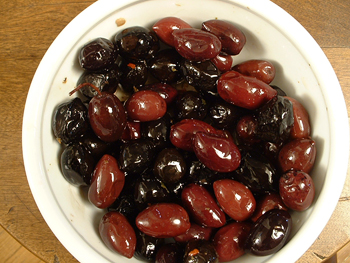
© Denzil Green
Black Olives don’t need to be cured, as green olives do. They will just be brined or salted to season and pickle them. They do, though, have to be pickled longer than green olives, because they didn’t have the curing process. They are usually ready to eat or package 70 days after harvest.
They have a sweeter, fuller flavour than green olives, though they lack the tartness and zing. Their texture will be softer.
They can’t be mechanically pitted, as they are too soft to stand up to the machines, so they are almost always sold with the pit still in. At least, that’s what the industry says — though somehow, the raisin industry has figured out how to sell pitted raisins, causing raisin pitters to disappear from kitchens around the start of the 1900s.
Black olives are sold in jars, tins or in plastic tubs at deli counters.
These are very different from the Californian Black Olives sold in North America. Those are green olives, dyed black.
Cooking Tips
Black Olives are the olives most often used to make tapenade.
Pitting them is quite time consuming. There are three ways. Which way works depends on what type of olive — some cling more to their pits — and, on how sore your hands get after a few minutes of doing this.
- Try to squeeze them until they pop out their pit; or
- Put on a cutting board, and whack with the side of a big flat knife, like a French knife, and hope that the pit will pop out on its own, or can be extracted easily; or
- Make an incision all the way around the olive, with a knife or by cutting with kitchen scissors, and pry the two halves apart to expose and extract the pit.
You might have to use a combo of all three on the odd stubborn olive.
Whichever way you go, you’ll find yourself thinking there’s got to be a better way, but astonishingly no one seems to have come up with anything else yet. Mind you, you can always pawn the task off on a friend.
|
Amount
|
||
| Calories |
39
|
|
| Fat |
3.5 g
|
|
| Saturated |
.4 g
|
|
| Cholesterol |
0 mg
|
|
| Carbohydrate |
1.7 g
|
|
| Fibre |
1 g
|
|
| Sugars |
0 g
|
|
| Protein |
.3 g
|
|
Language Notes
If a recipe calls for “ripe olives”, what it means is “black olives.”

